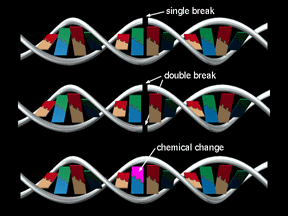Radiation can damage DNA molecules in three ways: by causing a single strand break, a break in both strands, or a chemical change or mutation. A single strand break can often be repaired by the cell. The other two types of damage usually cannot be repaired.
Click on image for full size
Source unknown.
Can living cells repair damage from radiation?
Whether or not a cell can repair itself after being damaged by radiation depends on the type of damage to the cell's DNA.
| Type of Damage |
Prospects for DNA Repair |
| Single strand break in the DNA |
Can usually be repaired and normal cell function restored. |
| Breaks in both DNA strands |
Usually damage is too severe for repair. The cell dies. |
| Chemical change or mutation |
Cannot be repaired. Cancer may result or a mutated offspring if this occurs in a sperm or egg cell. |
Cells (such as those contained in the skin, eyes and blood-forming organs [BFO]) that reproduce rapidly are the most susceptible to damage because they cannot repair themselves easily while replicating. Acceptable radiation doses are usually given separately for these organs.
You might also be interested in:
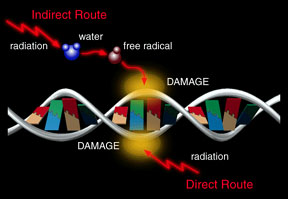
High frequency radiation or fast moving particles plow into a living cell with enough energy to knock electrons free from molecules that make up the cell. These molecules with missing electrons are called
...more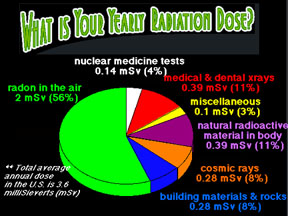
Radiation comes in two basic types: electromagnetic radiation transmitted by photons, and particle radiation consisting of electrons, protons, alpha particles, and so forth. Electromagnetic radiation,
...more
Jupiter's atmospheric environment is one of strong gravity, high pressure, strong winds, from 225 miles per hour to 1000 miles per hour, and cold temperatures of -270 degrees to +32 degrees (freezing temperature).
...more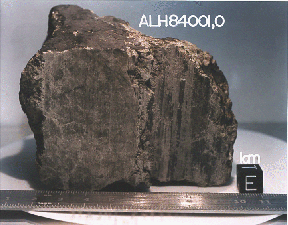
In July, 1996, it was announced that Dr. David McKay, along with a team of scientists at Johnson Space Center (a division of NASA), had discovered possible fossils of bacteria in a meteorite named ALH84
...more
Saturn's atmospheric environment is one of strong gravity, high pressure, strong winds, from 225 miles per hour to 1000 miles per hour, and cold temperatures of -270 degrees to +80 degrees. With winds
...more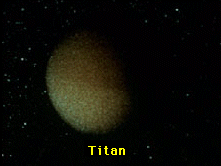
Titan's atmosphere is a lot like the Earth's, except that it is very cold, from -330 degrees to -290 degrees! Like the Earth, there is a lot of Nitrogen and other complex molecules. There also may be an
...more
Autotrophs are organisms that can "make their own food" from an inorganic source of carbon (carbon dioxide) given a source of energy. Most autotrophs use sunlight in the process of photosynthesis to make
...more


